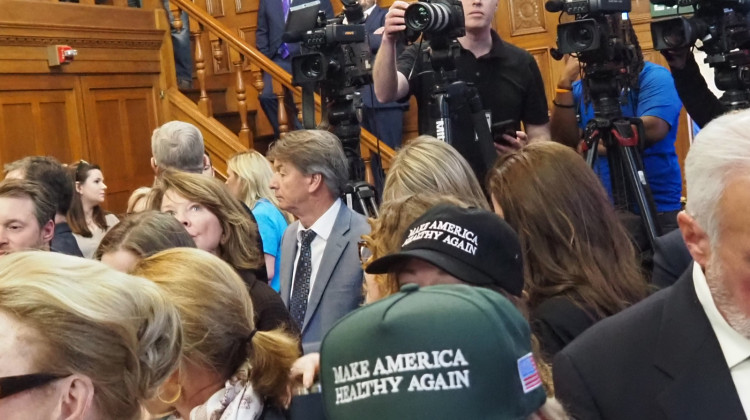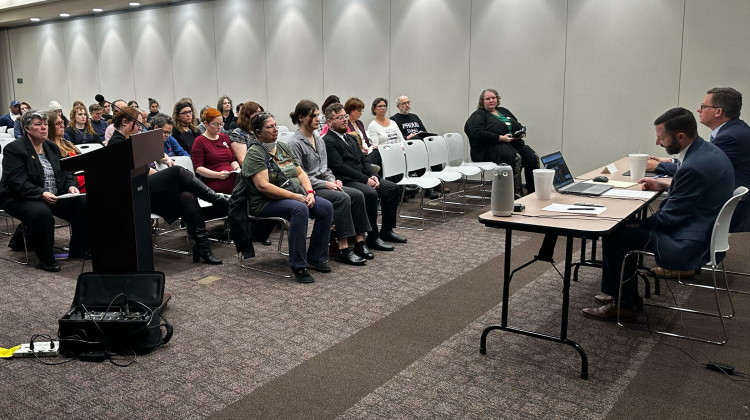
Indiana Attorney General Todd Rokita published a report that makes a number of claims, including what he said are inaccurate COVID-19 death counts and positivity rates from the state. Rokita also questioned how they were used to inform public policy decisions.
Brandon Smith / IPB NewsIndiana Attorney General Todd Rokita published a report that he said proves the state used “faulty” data to justify the Stay-At-Home order at the beginning of the COVID-19 pandemic. However, experts warn Rokita’s claims lack context.
In 2021, Rokita said he “doesn’t believe any numbers any more” and the data has been “politicized from day one.”
At a political rally on Saturday, he presented a report that makes a number of claims, including what Rokita said are inaccurate COVID-19 death counts and positivity rates from the state. He also questioned how they were used to inform public policy decisions.
The Regenstrief Institute worked with public health and health care agencies to gather and communicate data in the early days of the pandemic. Brian Dixon, the director of public health informatics at Regenstrief, said there were in-depth discussions around those public policy decisions and what data should be considered.
“We're looking at patterns of data and whether rates are increasing or decreasing when we're trying to make decisions,” Dixon said. “And those decisions are being made looking at multiple indicators, not just a single thing.”
Rokita points to 'flaws' in the state’s data
In the report, Rokita questions the validity of two specific points of data. The first is the state’s death count.
His office found “double-digit discrepancies,” according to the report. While Regenstrief was not involved in the data surrounding the state’s death count, Dixon said even if there is a concern around the overreporting of deaths, there were instances where there was also underreporting, especially at the beginning of the pandemic.
“There were people who were dying of a mysterious respiratory illness and we didn't know it was COVID-19,” Dixon said.
Dixon said people may have died before COVID-19 was an official diagnosis or they may not have gotten tested, resulting in COVID-19 not being considered the cause of death. The Indiana Department of Health audited its historic COVID-19 death count in February 2021, which added 1,507 deaths to the state’s total.
IDOH stopped updating COVID-19 data in September 2023. At that point, it counted 25,654 deaths, which is larger than the total populations of 32 Indiana counties.
The second concern surrounded the use of the positivity rate in determining the need for the “Stay-At-Home” order. Rokita’s report claims that an analysis “pulled from several studies” shows the state’s rate was substantially lower than reported, and the rate was based on biased testing.
However, Dixon said this misrepresented how the metric was used.
“What we tended to focus on from a public health perspective, in terms of monitoring disease, was really the rate of change,” Dixon said. “So if your positivity is going up, you know, week to week, then that means generally that disease is spreading.”
The rate was also just one of many metrics that officials considered. Dixon said decisions were based on trends in the data rather than a specific number from a specific day.
Rokita’s report also said the positivity rate could have been falsely “inflated” if someone who was positive tested multiple days in a row.
Dixon said this was something researchers and public health officials were accounting for, and adapted as they learned more about COVID-19.
“At the beginning of the pandemic, it was not clear how long someone would remain positive and test positive,” Dixon said. “That guidance changed over time. Initially it was thought that the course of disease would be within a week, which is similar to influenza.”
As the public health field learned more about the timeframe, the guidelines changed. Dixon also said data was based on the testing that was available at the time, which was extremely limited at the beginning.
Criticism of Stay-At-Home orders
Rokita’s report also claimed that the “lockdowns” had a variety of harms, and only reduced the spread by a small percentage.
However, Dixon said the paper Rokita’s report referenced to make this claim was a working paper.
“It hasn't been peer-reviewed or vetted by any other source,” Dixon said. “I would say that particular analysis only looked at data from the first couple years of the pandemic.”
He said researchers have had time to look at non-pharmaceutical interventions, such as masks and “Stay-At-Home” orders; there have been a number of studies that have identified their benefits.
Join the conversation and sign up for the Indiana Two-Way. Text "Indiana" to 765-275-1120. Your comments and questions in response to our weekly text help us find the answers you need on statewide issues.
Recommendations and use of historic public health funding
Rokita made multiple recommendations in the report, including using Indiana’s historic public health funding to conduct an independent review of the data used to inform policy decisions and how effective those policies were. In addition, the report calls for a third party audit of medical files that list COVID-19 as a cause of death.
Dixon said health departments expect to use that funding to address public health concerns like diabetes, heart disease and cancer. He said instead of redirecting those funds to this type of audit, health departments could focus on making sure they are utilizing the latest information to keep their ongoing data collection up to date.
READ MORE: How the public health system overhaul came to be – and what’s still left to do
At the beginning of the pandemic, public health officials were developing how they worked with data as they were learning about COVID-19. Dixon said data can be messy or incomplete, especially with so many factors changing as fast as they were in 2020.
“There were a lot of lessons around the need for coordination, not only within public health, but between public health and health care and, of course, community organizations,” Dixon said. “Because it really took a whole village to expand our testing and expand our vaccination efforts, through the COVID-19 pandemic.”
While Dixon said the report is missing some important context, he said the concerns within it point to continuing to invest in public health infrastructure for any future public health crisis that may develop.
“If anything, this report highlights a small piece of why we need to build a better public health system,” Dixon said. “And we need to focus on continuing that work to make Indiana more prepared next time.”
The IDOH did not respond to a request for comment. Gov. Eric Holcomb’s office directed questions to the IDOH.
Abigail is our health reporter. Contact them at aruhman@wboi.org.
 DONATE
DONATE







 Support WFYI. We can't do it without you.
Support WFYI. We can't do it without you.